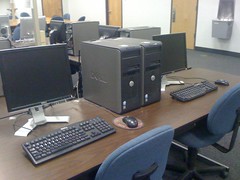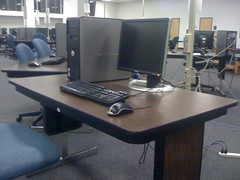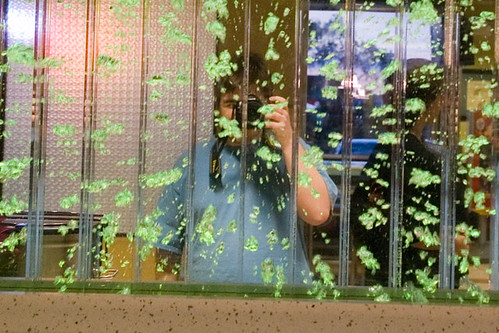 You might know that my job involves sitting around here in the South Learning Assitance Center quite often. In addition to the fact that I really like to sit around here at the lab, I really like analyzing the setup, and tracking changes. So when in the past few days I started getting weird opportunities to see other computer labs on campus, I was naturally very excited to see how other departments set up their labs.
You might know that my job involves sitting around here in the South Learning Assitance Center quite often. In addition to the fact that I really like to sit around here at the lab, I really like analyzing the setup, and tracking changes. So when in the past few days I started getting weird opportunities to see other computer labs on campus, I was naturally very excited to see how other departments set up their labs.
I'll start off by explaining that I work in an NAU ITS lab, which is considered to be the standard of labs here on campus. Residence hall labs are also on the same standard image as the machines. The whole system is set up to authenticate and load profile settings directly from dana, which is the definitive student file/mail/web server on campus, and which also happens to be a Solaris 8 box. The problem with the ITS lab image is that it's slow. 2.0GHz Core2Duo machines like our OptiPlex 745 machines feel slow and unresponsive when logging in, and I really do think the organization of everything on the lab image is rather atrocious. The ITS-Labs Macintosh computers are even worse.
The first lab I had the opportunity to see last Thursday was a lab in the art building. It's apparently a very highly gaurded secret, so I will probably receive a talking-to from my girlfriend (an art major) about this blog post, but suffice it to say that from the quick peek I got, it looked clean and well-maintained. There were two labs next to each other, one with Windows and one with Mac OS. The Windows lab was closed though, and the Mac lab appeared to have all Music keyboards. I don't know whether or not this lab authenticated directly from dana, or if it was like the Babbitt LLC described below.

Another lab with which I've had the opportunity to become a bit more familiar is the Language Learning Center in the Babbitt Academic Annex. The lab was very clean, I'd go as far as to say it was imMaculate (horrible horrible pun), and it was filled completely with well-running G5 iMacs. The system authenticates against the same NAU LDAP setup as the rest of the labs do, but I think it does its actual authentication against a server that resides in the Babbitt building. I think home folders on that system may be on the MODL server. I noticed my login was very quick, and the environment was set up in a very very clean way. The dock was filled with only the apps that were really relevant, and my dana samba share was right there on the desktop.
Upon login at the LLC lab, Safari immediately opened and displayed this rather-helpful wiki page. It isn't actually the most helpful thing ever, but the concept is great, and with a bit of work it could become the definitive way to educate self-starting users about what's available in the lab, and how to go about doing things. Also, I really like the OS X Server 10.5 start page, and the built-in wiki/blog/calendaring functions look really cool. I've got to admit, I wish I had a Leopard server hanging around.
There are two departments on campus, just that I know of, that stray completely from the NAU-STUDENTS\ domain and use their own completely Mac or Windows based solutions, which is cool because they are typically much more efficient, having been implemented on a much smaller scale. On the other hand, it makes supporting users from the W.A. Franke College of Business Administration and the School of Communication rather difficult, because we're unable to help them with their passwords, login procedures, or even in the case of the SoC, the exact name of their login account.
The W.A. Franke College of Business Administration uses a windows domain with a really long esoteric name that's super difficult to type in when you're attempting to connect to it from home. On the other hand, what I found out is that it all pretty much "just works" when you're in the actual building. The Sun Ray thin clients are awful, slow little pieces of hardware, but their 2.0GHz Core2Duo OptiPlex 755 systems in the labs are really fast little computers, and they've got a lean and efficient set of software (mostly Office 2007 and VisStudio 2005) installed. The systems are also left in an attractive default Windows Classic scheme, in contrast to the ugly custom colors used on the ITS Labs image.
The School of Comm, whose principal server is called Titan, has a pretty interesting (one-server) setup. It's very similar to the network I set up at Kingman High School last summer, but bigger and with more users. Like the FCBA network, it's fairly efficient and you can usually be logged in and examining files fairly quickly, although they've taken less care to actually transfer all of their students uids over properly, and unlike the IT department in the FCBA, the School of Comm's network is managed only by one person. Also, their datacenter is less impressive, with only three racks, each with only one or two pieces of equipment. For shame. For shame. (Two xserves, an xserve raid, one or two powermac G4s, and the EditShare server.)
It's definitely interesting to see the differences between massive labs like the one here in the S-LAC that has a lot of computers that run slowly, and the smaller school-specific labs that, despite having fewer staff members, always seem to be cleaner and run better. I wonder if it's an effect of the fact that the S-LAC is open twenty four hours daily, or the fact that ITS labs have so many employees, whereas some of the smaller labs are either unmanned, but maintained by their full time staff, or if the size of the computer facility even has something to do with it.
My guess is that it's a weird combination of all of the above. The SLAC is a great lab, but from what I can see, the staff aren't all that well connected, the fact that the lab runs 24/7 means that there's often not enough time to do maintenance or things like shuffling computers around, and I've noticed that the whole arrangement of the lab just isn't as attractive as some of the other labs on campus. The feeling I get from the S-LAC is that it's primarily "a room with computers in it," whereas from some of the other labs on campus, I get the 'workspace' feeling.
 It makes a huge difference to have a defined area for your work station, where you can shuffle through papers and everything, and I notice so many people who use the S-LAC tend to head toward a certain computer depending upon what they want to do. I've noticed that it's not that big of a problem for a younger person who only needs to check their MySpace or Facebook to use one of the "line computers" as I call them, which are on the east side of the lab, where there's nowhere to spread papers out. Whereas people who are always working on big projects prefer the computers that sit on their own midsized desks, or the computers that are alone on the long tables (there are one or two like that.)
It makes a huge difference to have a defined area for your work station, where you can shuffle through papers and everything, and I notice so many people who use the S-LAC tend to head toward a certain computer depending upon what they want to do. I've noticed that it's not that big of a problem for a younger person who only needs to check their MySpace or Facebook to use one of the "line computers" as I call them, which are on the east side of the lab, where there's nowhere to spread papers out. Whereas people who are always working on big projects prefer the computers that sit on their own midsized desks, or the computers that are alone on the long tables (there are one or two like that.)
I also think that the design of the S-LAC gives people a certain attitude about its use. Because they think of the S-LAC as merely a room with computers, it doesn't matter so much to them that they leave trash around, or draw on the desks, because it's not so much their responsibility to keep everything looking nice, as it is with users of labs in individual colleges. Either that, or in the smaller labs, staff are responsible for picking up after the users on a regular basis, which I can tell you based on my experience with the overnight shift, does not happen at all here at the S-LAC.
I really do think it's possible for the S-LAC to be an even more top-notch lab than it already is. We've got great equipment, and the building really is a pretty good design as far as labs go, but I'm going to end this rather long post here. I may elaborate a little bit in the future though, on what changes I would make to the SLAC to turn it into a better work environment for students.




No comments:
Post a Comment